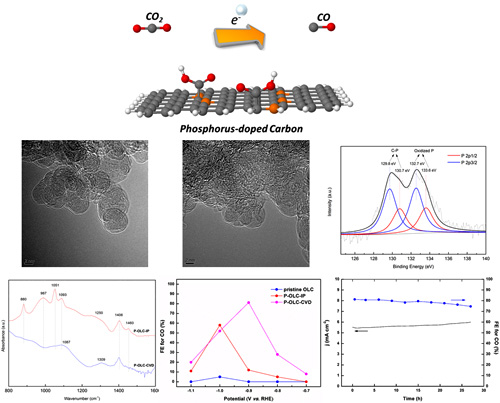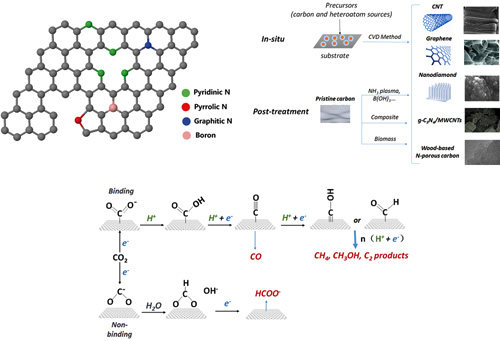With rapidly increasing of CO2 in the atmospheric concentration in the past two centuries, the greenhouse effect has become a pressing issue for mankind.CO2 electrochemical reduction (CERR) is a promising chemical fixation method which could convert CO2 into useful low-carbon fuels or chemicals using electrons as clean reductant under mild conditions, attracting great attentions from the scientific community. Cathode materials in CERR play a crucial role for the mechanism, electro-kinetics, and product distribution. There is an urgency to search for active, selective, stable electrocatalysts for CERR. Aside from the traditional metal catalysts, metal-free carbon materials are emerging as promising alternatives because of the high overpotential for hydrogen evolution, relative large active surface area, excellent stability, and low cost.
Recently, Associate Professor Li Bo and his colleagues from Institute of Metal Research, Chinese Academy of Sciences, present a research focused on the phosphorus-doped onion-like carbon (P-OLC) for CERR. Two phosphorus bonding states, P-C and P-O are discovered with multiple methods of characterization (XPS,DRITFS,TGA,TPD) on the P-OLC synthesized from different preparation strategy. It is very interesting to note that the P-OLC with P-C bond is much more active for CERR, comparing to the P-OLC with P-O bond. The P-OLC with P-C bonding exhibits outstanding CERR performance, with partial current density of 4.9 mA/cm2, 81% Faradaic efficiency, and excellent durability (27 h) at low potential (-0.90 V vs. SHE). Density functional theory calculations show that the binding energy of the key intermediates COOH* on P-C bonding is much bigger than counterpart on P-O bonding. Moreover, partial density of states (PDOS) analysis suggests that electron transfer capability on P-C bonding is stronger than P-O bonding.Current study demonstrates that phosphorus doping is an effective strategy for fabricating carbon CERR catalyst and reveals the pivotal role of phosphorus bonding configuration.
The research is published in Journal of Materials Chemistry A which is recommended as Article on inside Back Cover and selected by editor as 2018 HOT PAPER. This is the second paper from Professor Li Bo’s group selected as HOT PAPER in Journal of Materials Chemistry A, preceded by another DFT study on the CO oxidation on gold single atom catalyst tuned by heteroatoms doped on CNT support.
Since 2016, Li has been working on the carbon-base catalysts for CERR, including boron-doped mesoporous carbon, nitrogen-doped graphene, and CNT-graphene composite materials. Based on the previous works, Li is invited to contribute a Highlight article on Journal of Materials Chemistry A to fully summarize the current research on the heteroatom-doped carbons for CERR, titled “CO2 Electoreduction Reaction on Heteroatom-doped Carbon Cathode Materials”. The Highlight article comprehensively covers the heteroatoms (nitrogen, boron, sulfur), carbon substrate (CNT, graphene, biomaterials, nanodiamond), distribution of products (CO, HCOOH, CH3OH, multi-carbon products), and mechanisms (key reaction intermediates, active sites tuned by heteroatoms). The Highlight clearly illustrates that the doping strategy is crucial for the fabrication of carbon catalysts for CERR, and sheds light on the future development of carbon catalysts.
The above researches are supported by NSFC,Institute of Metal Research,SINOPEC. Super Computation ofGuangdong Joint Fund.

Figure 1.The illustration, characterization, and performance of phosphorus-doped carbon. (Image by IMR)

Figure 2.The illustration and summarization of the synthesis methods, mechanism of the heteroatom-doped carbon for CERR.(Image by IMR)